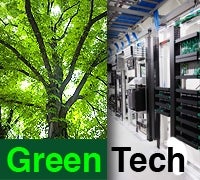 |
Coinciding with Earth Day, storage giant Seagate today unveiled a new family of drives called Barracuda LP — the “LP” signifying a low-power design that’s aimed at drawing less energy.
The new drive comes in 1 terabyte, 1.5TB and 2TB capacities, feature 32MB of cache and utilize either one, two or three 500GB platters.
“This is a fairly major launch for us — it’s the first time Seagate has expanded the Barracuda desktop line with a whole new product family,” said Ann Haggar, product marketing manager for the drives. “We believe we have found the right balance of performance and low power.”
Seagate’s certainly not the only hard drive vendor pushing green models. Earlier this week, rival Western Digital introduced a new environmentally friendly drive of its own.
But Seagate claims that the LP is the most energy-efficient drive in its class, but the company’s green effort doesn’t stop there. The drives are fully compliant with industry standards that restrict hazardous substances, and more than 70 percent of the material used in the drives is recyclable, it said.
Another key feature with green IT implications is “SecureErase.” It allows a drive to be completely erased — up to military standards — and repurposed. Because of security concerns, many corporations shred or destroy hard drives rather than redeploying them for fear of someone recovering sensitive data.
Another advantage of these drives is that they run cool, Seagate said; that translates to less fan power and longer life, both green-friendly features.
Although these drives draw less power, Seagate packs a little bit of magic to make sure the drives still deliver performance. Once interesting choice is the unconventional speed of 5900 rotations per minute, 10 percent faster than conventional 5400 drives, but slower than power-hungry 7200 RPM drives.
The green enhancements may play well with the Earth Day crowd, but Jon Goodman of Seagate’s competitive analysis group admitted that the actual power savings might not be that spectacular for the average consumer or small business user.
“At the plug level, it’s not a huge amount. Over our 7200 RPM drive, after the efficiency of the power supply is taken into account, you will have a total savings of about two and a half kilowatt-hours over a one-year period.”
Even in a local with high energy rates, like New York City, the total savings utilizing this drive would be around 50 cents per year. When you allow for the fact that many power profiles will power down the drive when it isn’t in use, that number would be far smaller.
By comparison, with the same usage, replacing an incandescent bulb with a compact florescent bulb can achieve the same savings in only 10 days. It’s clear that if your goal is to build a green computer, you have to go way beyond replacing the hard drive.
At the corporate level, it is a considerably different story. Storage cabinets full of disks can generate a considerable about of heat. In high-use applications, the saving are more significant.
Pricing for the drives starts at $358, $156 and $118 for the 2TB, 1.5TB and 1TB capacities, respectively. Shipping dates have not been announced.


